
You Can Only Carry So Much
If you’re a hunter, soldier, or building an ultralight bug out bag, weight is always a consideration. You may be wondering – how much does ammo weigh? Hopefully these ammo weight charts might help.
My Ammo Weight Concerns
Last year I had an unexpected surgery that imposed temporary physical limitations. With bird season was right around the corner, the worst part was its timing. My Labrador was looking anxious so, rather than sit out October, I explored every possible way to lighten my upland hunting load.
In my area, pheasants are a rare commodity and, as luck would have it, the one local hotspot was tough going due to steep hills and a maze of old stone walls. The usual12 gauge shotgun best covered the open terrain but spare shells, water for the dog, and various other items added up to lots of weight – even without a pair of ringnecks in the game vest.
TV outdoor shows being the cruel alternative, I dragged out a digital scale, accurate to within 1/10th ounce. Next, I reached into the safe and began weighing shotguns. The most practical candidate turned out to be a light 20 gauge semiauto.
Compared to my trusty 12 gauge, the twenty shaved off an honest 22 ounces – much better than expected! However, this comparison involved unloaded shotguns. Like many other folks who hunt with autoloaders, mine are normally stoked with three shells.
Typically, I carried at least sixteen extra 12 gauge shells (to cover woodcock in adjacent cover). Looking to shed more weight, I reduced the spare 20s to just ten. Good news! The scale and some math indicated this strategy could eliminate 17.4 ounces of total ammo weight.
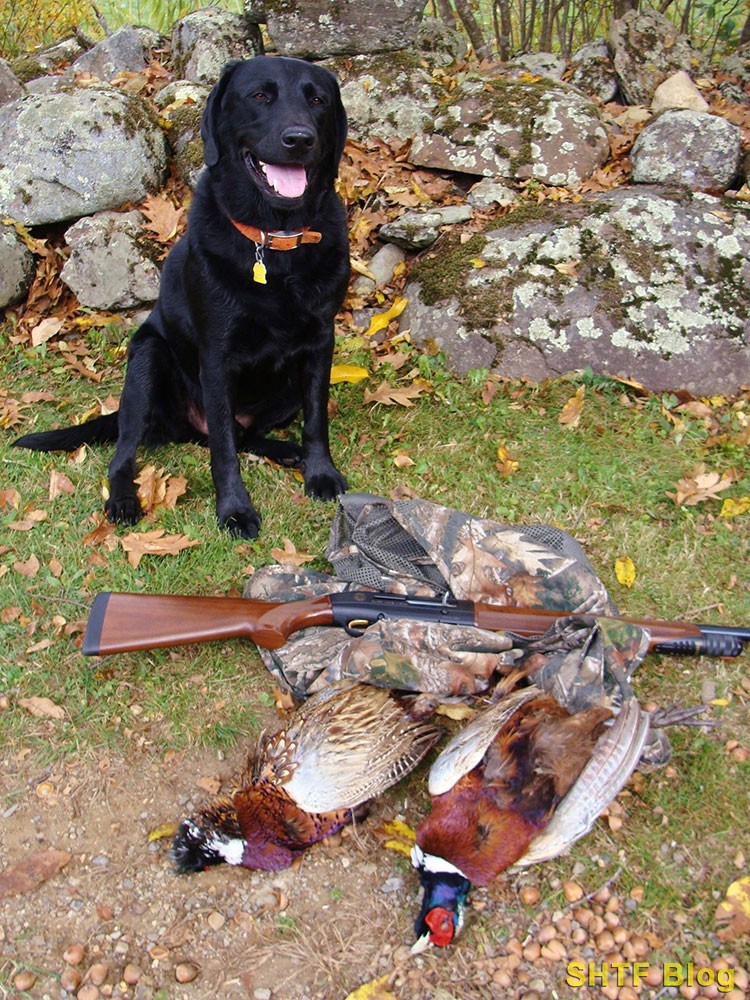
Between the lighter shotgun and a lesser quantity of smaller shells, I was able to dump 2 ½ pounds – not bad. Next, I lightened my load in every other way possible, including a switch to featherweight boots. The difference was immediately apparent once afield.
Actually, this little project had a familiar theme. As everyone who humped the boonies knows, extra ounces soon become pounds!
Oscar Mike (On the Move)
A previous life found me toting an M-16 which fired the smaller and more portable 5.56 NATO cartridge than its predecessor; the 7.62 NATO M-14. Although the 5.56’s advantage was more bangs per pound, on foot every ounce still mattered. Ammo competed with other essentials (a big one being water) so, in my small squad, fifteen magazines was usually max (loaded with 18 rounds in each). This, for a scrappy squad of young G.I.s who got plenty of exercise.
The weight of ammo carried in the field, with everything else needed, is precisely why soldiers have to carefully plan how much ammo they need to carry. If you’re wondering how much you need for general purposes, try out our ammo calculator for the results (and more on this subject of weight).
Depending on the mission, we might bump up to around 400 rounds at the expense of other items. Occasionally, a big noisy fan would blow off some of our sweat, but even helicopters have weight limits. Toss 8-9 heavily laden guys in a fully crewed and fueled UH-1D “Huey” and it might not achieve liftoff in tropical heat at mountainous altitudes.
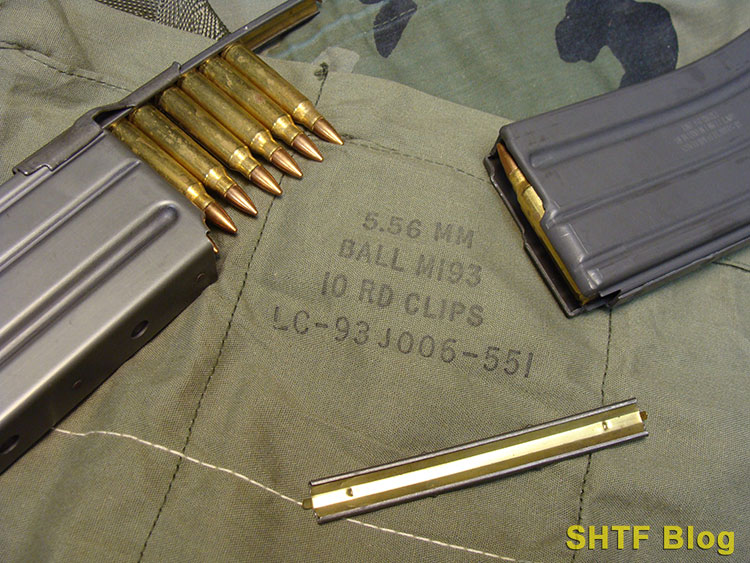
Nowadays, like most others, I consider a jumbo-sized ammo stash a good thing. But problems can still arise if mobility becomes necessary – especially if not alone. Being wired for weight, bush pilots have their own definitions of “essential gear.” The same is true for those who pilot small boats in big water. Vehicles, rough roads and excessive weight don’t mix well either.
An average family of vacationers stuffed in an SUV can be bad enough. A group of preppers could find themselves jettisoning supplies and good relations without a detailed bug out plan. Ever heft a full G.I. can of ammunition? One is bad enough! You probably won’t be carrying it on foot for long, regardless of the rounds within – and loose rounds are even heavier!
Ammo Weight Charts
The problem with all of the different ammo weight charts you’ll find online in various places is that there are so many variables. You can’t just say “How much does a 9mm cartridge weigh?” and expect a consistent, exact answer. Brass casings weigh more than steel casings. Higher grain bullets weigh more. You get the idea.
What I did was actually put these different, commonly caliber cartridges, on a scale to record the differences. These are real world, first-hand results. They should work to answer most everyone’s question “How much does ammo weight?” Well, at least for these most common calibers.
Handgun Ammunition Weights
For pure portability, the 9mm is hard to beat. I pretty much ripped the house apart in search of a 115-grain version to no avail, hence the 124 shown ammo weight chart below.
| Cartridge | Bullet | Ea-gr | Ea-oz | Lb | Box | Box-wt |
|---|---|---|---|---|---|---|
| 9mm Federal AE | 124-gr | 186 | 0.43 | 37 | 50 | 22.8 oz |
| .45 ACP G.I Ball | 230-gr | 325 | 0.74 | 21 | 50 | 37.8 oz |
| .45 ACP CCI Blaser (alum) | 230-gr | 270 | 0.62 | 26 | 50 | 33.1 oz |
| .357 Mag Win Super-X | 158-gr | 207 | 0.47 | 33 | 50 | 30.9 oz |
| .44 Mag Comm Reload | 240-gr | 380 | 0.87 | 18 | 50 | 44.8 oz |
| .44 Mag CCI Blaser (alum) | 240-Gr | 293 | 0.67 | 24 | 50 | 35.6 oz |
Another revelation: On previous rare occasions, if armed solely with a 1911, I’d carry 13 extra G.I. mags, amounting to 91 rounds, in a bag (plus 8 rds in the pistol. Also reassuring, they felt like they weighed a ton and would beat you to death unless firmly secured.
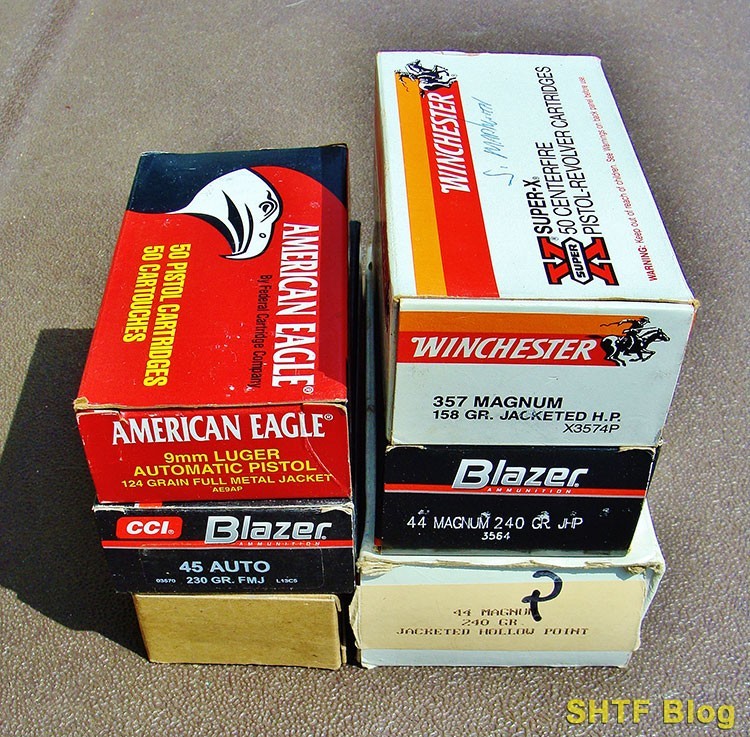
According to the data though, the spares only added up to around 6 pounds. Apparently, weight distribution can make a big difference! Today’s CCI’s Blaser aluminum-cased 230-grain .45 ACP rounds would net an 11.44-ounce savings.
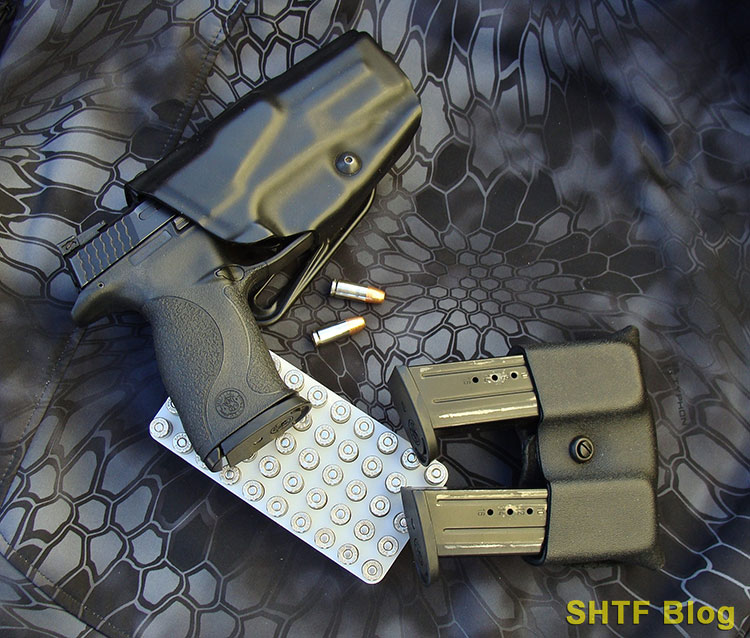
Actually, many of today’s expanding 9mm loads are more effective than old .45 ACP hardball. The latest genre of polymer 9mm pistols also hold more ammo. Five 17-round magazines would provide a similar quantity (85 rounds) while shedding more than half the weight – 3 ¼ pounds!
The lesser quantity of spares would be more than offset through increased capacity of the pistol. Except for big-bear country, I wouldn’t rule out a .357 Magnum, either!
For more information on handguns, consider my book Handguns: A Buyer’s and Shooter’s Guide:
- Markwith, Steve (Author)
- English (Publication Language)
- 418 Pages - 07/13/2019 (Publication Date) - Prepper Press (Publisher)
Rifle Ammunition Weights
Rather than list the weight of some arbitrary quantity (such as 100 rounds), I weighed a few common rounds individually (shown in both grains and ounces). This should help calculate the number of rounds per pound. If your .223/5.56 load is a differs, say, 62 grains, no problem; just tack 7 extra grains on the 176-grains below. Cases and propellant weights will vary somewhat, but the figure should be fairly close.
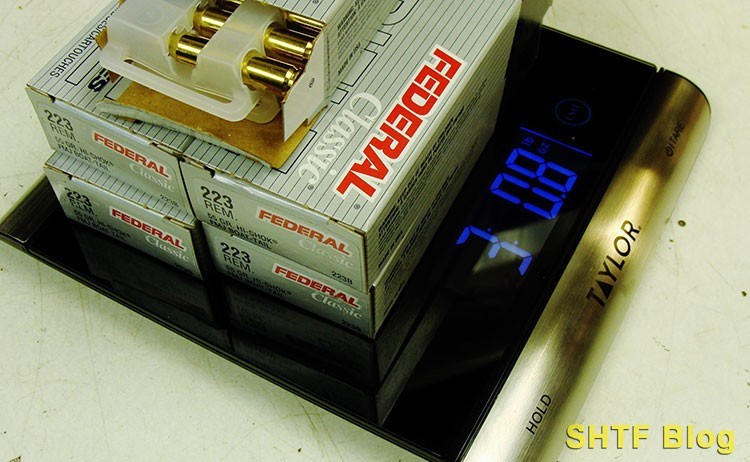
I rounded off the per-pound weights, biased to the minimums. FYI, there are 437.5 grains per ounce, and 7000 grains per pound. In deference to those packing ammo by the box, I also weighed one of each.
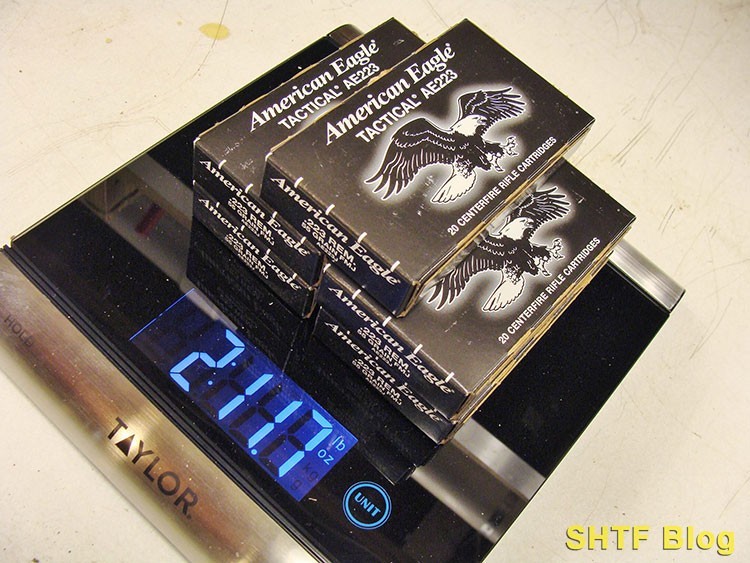
| Cartridge | Bullet | Ea-gr | Ea-oz | Lb | Box | Box-wt |
|---|---|---|---|---|---|---|
| .22 LR Rem Thunderbolt | 40-gr | 52.5 | 0.12 | 133 | 50 | 6.2 oz |
| .223 Fed Ballistic Tip | 55-gr | 176 | 0.40 | 38 | 20 | 8.1 oz |
| .243 Rem Core-Lokt | 100-gr | 310 | 0.71 | 22 | 20 | 15.7 oz |
| .30/.30 Rem Core-Lokt | 150-gr | 320 | 0.73 | 22 | 20 | 16 oz |
| .308 Rem Core-Lokt | 150-gr | 368 | 0.84 | 19 | 20 | 18.3 oz |
| .30/06 Rem Core-Lokt | 150-gr | 406 | 0.93 | 17 | 20 | 20.1 oz |
A woods-wise prepper could do worse than carry a .22 rimfire rifle, traveling long distances on foot. A 500-round brick of Thunderbolts weighed exactly 3 lb., 15.1 oz. – a bit less than eight boxes of 5.56, or four boxes of .30/30s. Note the relatively minor disparities among the larger conventional cartridges.
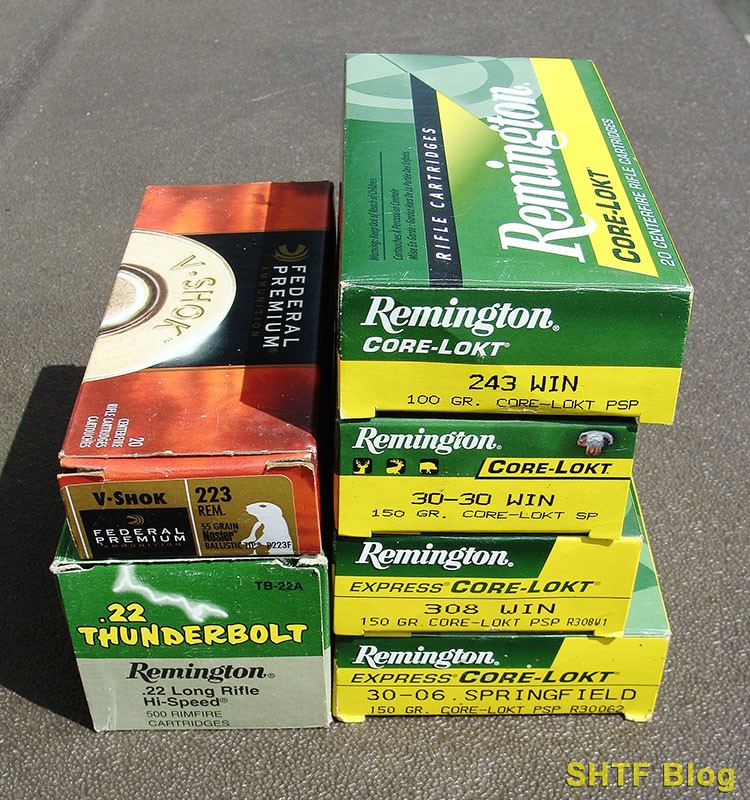
For more on centerfire rifles, consider my book Centerfire Rifles: A Buyer’s and Shooter’s Guide:
- Markwith, Steve (Author)
- English (Publication Language)
- 264 Pages - 12/03/2016 (Publication Date) - Prepper Press (Publisher)
Shotgun Shell Weights
It’s really hard to beat the versatility of a repeating shotgun – especially one with easily interchangeable barrels. The downsides are somewhat limited range compared to a centerfire rifle, and the larger size of ammunition. The only shell I could weigh in grains was the .410-bore (398 grs.). The rest were too heavy for my reloading scale!
| Shell | Load | Ea-oz | Lb | Box | Box-wt |
|---|---|---|---|---|---|
| .410 3” Mag Win Super-X | 11/16 oz | 0.8 | 20 | 25 | 22.6 oz |
| 20 Ga. 2 ¾” Win AA Target | 7/8 oz | 1.2 | 13 | 25 | 31.7 oz |
| 12 Ga. 2 ¾” Win AA Target | 1 1/8 oz | 1.5 | 10 | 25 | 39.7 oz |
| 12 Ga. 3” Mag Win XX Turkey | 1 ¾ oz #5 | 2.3 | 7 | 10 | 23.2 oz |
| 12 Ga. 2 ¾” Win Super-X | 9-pellet 00 B | 1.6 | 10 | 5 | 8.4 oz |
| 12 Ga. 2 ¾” Win Super-X | 1-oz Slug | 1.5 | 10 | 5 | 7.9 oz |
Having done some upland hunting with .410s, compared to a 20 Gauge, it seems like you could almost take flight, even with a vest full. But, for practical use, the latter is a better minimum. Most can also fire 3” Magnums that have lots of extra clout. My stalwart issued gun was a 12 Ga. Remington Model 870 Police pump, equipped with a 7 +1 magazine and 6-shell side-saddle.

My basic load was thirteen 00 Buck (empty chamber) and two spare slugs on my belt (no more bandoleers for me). Truthfully, I never felt unprotected and that amount was plenty to carry, even with a sling. But, if need be, 100 extra shells in a pack would add up to the manageable ten-pound benchmark.
For more on shotguns, consider my book Shotguns: A Comprehensive Guide:
- Markwith, Steve (Author)
- English (Publication Language)
- 190 Pages - 11/27/2014 (Publication Date) - PrepperPress.com (Publisher)
Common Loaded Magazine Weights
Funny thing though: Despite all the preaching about weight versus mobility, I’d never actually weighed a loaded M-16 magazine. After tinkering with shotshells, it occurred to me that the weight of fifteen 20-rounders (twenty 5.56 rounds in each), could provide a reasonable benchmark for a bug out kit.
This approach would (in theory) leave enough leeway for other essentials capable of supporting a multi-day trek to somewhere else (hopefully a bug out location with more provisions). Some folks may start out in better style, but a breakdown or empty fuel tank could still result in a lengthy hike.
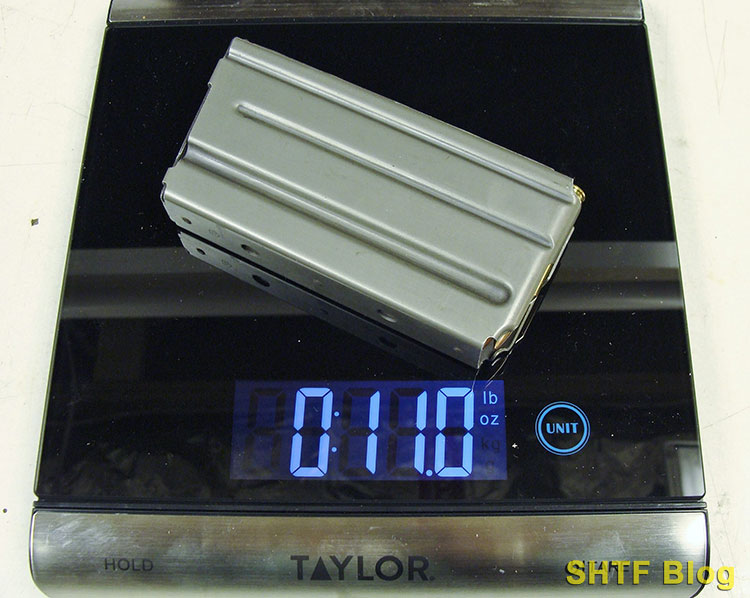
I was surprised at the weight of fifteen 20-round AR magazines totaling 300 rounds (55-grain .223/5.56). Truthfully, I thought it would be much more. Goes to show the effects of other necessary items (especially water) when traveling on foot. Having carried closer to 400 rounds at times, I was curious to see how today’s popular 30-round P-Mags would compare.
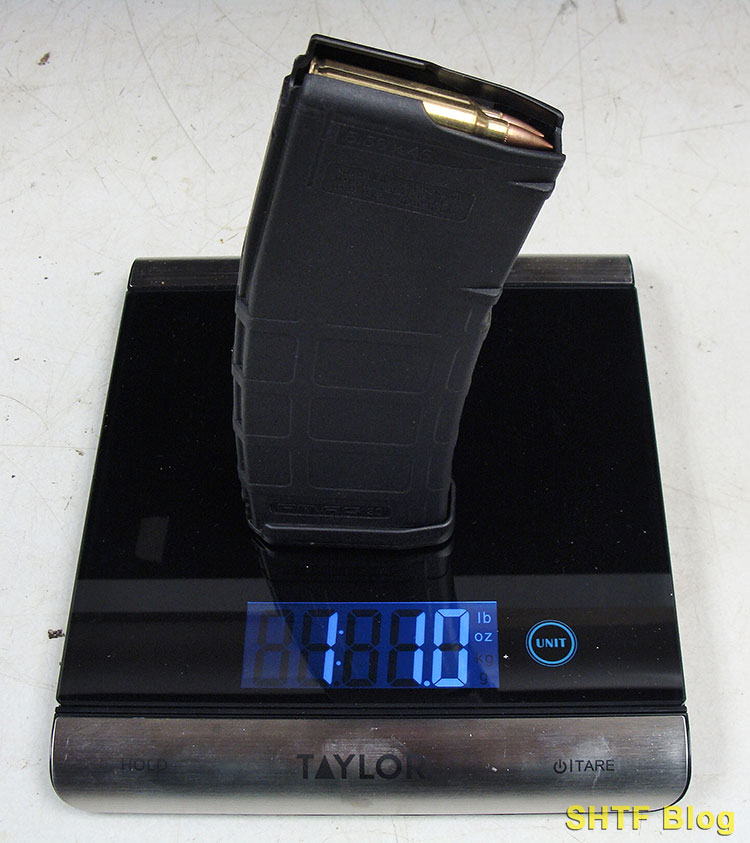
| Magazine | Empty | Cartridge | Loaded | Qty | Total Wt. |
|---|---|---|---|---|---|
| M-16 G.I. 20-rd | 2.8 oz | 5.56, 55-gr | 11.0 oz | 15 | 165 oz/10.3 lbs. |
| M-16 P-Mag 30-rd | 4.8 oz | 5.56, 55-gr | 17.0 oz | 15 | 255 oz/15.9 lbs. |
| Glock P-Mag 17-rd | 1.7 oz | 9mm, 124-gr | 9.1 oz | 3 | 27.3 oz/1.7 lbs. |
| 1911 Kimber 7-rd | 2.3 oz | 45 ACP, 230-gr | 7.5 oz | 3 | 22.5 oz/1.4 lbs. |
The handgun magazines are guestimates of common “basic loads,” the number carried by many LEOs on their belts (one of which would be in the pistol). CCW folks often carry just one spare. In bug out mode, plenty of extras could be stashed in a pack. A 9mm carbine fed from Glock magazines opens up lots of possibilities…
Ammo Weight Summary
The ammo weight charts provided here might help you figure out which firearm is best suited to each mission, but one lesson learned the hard way is this: A bunch of spare ammo on your person won’t do any good if you can’t reach at least some of it in a hurry.
To maintain maximum defensiveness, train access (and operate) the firearm and ammunition in any light, from any position, and with either hand. The reason? Murphy’s Law!

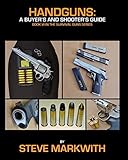


2 comments
It surprised me that the per round weight of the loaded GI 556 mag was lighter than the PMAG. I guess there is something to be said for aluminum.
Are you comparing the 20rnd to the 30rnd?